Disclaimer: A portion of this review contains racist and xenophobic caricatures and stereotypes. Intended to be presented in a historical and informational context, I do not condone any of these harmful ideas. With that said, I encourage you to speak up and tell me if I say something that is harmful, ignorant or offensive. It is never my intention and I would like to take accountability, should that occur. Thank you.
Release Date: November 5th, 1938
Series: Looney Tunes
Director: Bob Clampett
Story: Ernest Gee
Animation: Norm McCabe
Musical Direction: Carl Stalling
Starring: Mel Blanc (Porky, Gambler, Woman, Fire Swallower, Tour Guide, Voices, Lew Lehr), Danny Webb (Humpty Bumpty, Vendor, Voices, Lone Ranger), Berneice Hansell (Voices), Treg Brown (Voices), Bob Clampett (Voices)
Bob Clampett verges into "screwball comedy meets psychodrama" territory in this underrated but exceedingly memorable gem. I failed to mention in my review of Porky's Naughty Nephew that Clampett, after more than a year, has finally gotten story credits; Nephew marked the writing debut of Warren Foster, who would primarily be one of Clampett's main writers all the way up until 1946, and Porky in Egypt marks the writing debut of Ernest "Flash" Gee, a high school buddy of Clampett's.
On working with Gee, Clampett explained that he wasn't so much of a writer as he was a gagman, his best ideas being spontaneous. So, they'd get together and play a couple of rounds of ping-pong or go to the drive-in at night and discuss cartoon ideas rather than stewing around and thinking up ideas.
In any case, Egypt once more follows Clampett's trend of placing Porky in the explorer role, plopping him down in an eccentric environment and having him react to it. Here, tourist Porky gets stranded by his tour group. In an attempt to catch up, he pursues the caravan with his trusty camel, Humpty Bumpty, before the two eventually succumb to the brutal desert heat.
Clampett makes practical use out of his title card. Serving as a set piece rather than a piece of design, the tunnel framing the silhouette of the city expands past the camera as it trucks into the village, creating a nice illusion of depth.
Seeing that The Society of Muslim Brothers had about 300 branches in Egypt around 1938, Clampett gets topical in his introductory sequence, having a man in silhouette exit the top of a mosque and lead a prayer through the village.
The scenes read as a bit xenophobic and Islamophobic today, with Mel Blanc merely crying gibberish, but there is at least an attempt to be artsy; similar to the sunrise sequence in Porky in Wackyland, Clampett reveals the action by having the silhouette fade as the sun rises, exposing the buildings and mosques within the village.
Another shot of the villagers praying in the streets to set the mood. While the prayers introduce the atmosphere of our setting, Clampett introduces the atmosphere of the cartoon by revealing the villagers not conducting a service...
...but instead playing a game of craps. As soon as the dice are rolled, the solemn, stoic villagers are much more akin to Clampett's personality--wide grins and tall eyes. The gambler, a stark contrast to the bellows of his prayers, speaks in typical, high pitched Blancanese.
"C'mon, seven! Baby needs a new pair a' shoes!" Blanc's deliveries are delivered with an African American Vernacular English dialect, perpetuating the stereotypes that Black people are obsessed with gambling and shooting dice. Needless to say, two birds with one stone were hit in terms of defamatory caricatures.
In any case, we pan over to another stereotype; the sultry, alluring belly dancer strutting through the streets. Offscreen cat calls are copious.
Both her strutting and the music score of "A Vision of Salome" come to a pause as she prepares to remove her niqāb in an act of sexual allure and vulnerability.
"Seductive woman who is actually incredibly grotesque" was a favorite gag of both Bob Clampett and Tex Avery alike. Here, the woman's facial design and giggly Blanc falsetto reek of Clampett's earmarks as she giggles "Hello, boys!" John Carey's animation is at the very least a good match for such elastic and goofy expressions.
Manic laughter ensues as she covers herself back up, posing for the audience in hysterics. All issues aside, the poses are at least well executed, and Blanc's shrill giggles juxtaposed with her rapid fire poses are amusing.
Izzy Ellis animates the next gag of a fire swallower. Sitting on a bed of nails, needles poking out of every orifice of his skin, with knives (and more needles) protruding from his turban. Clampett goes so far as to have an entire knife sticking through the man's gut, protruding at both ends. At the very least, Clampett's whimsicality and design sensibilities break up any standard monotony, for better or worse.
The man's eyes shift to the audience in time with the music in a nice, subtle detail. A pause as he stares us down before reaching into a boiling pot with a flourish, unearthing a stick of fire and gesturing to as such. Ellis' animation wasn't as solid nor appealing as his fellow animators at the time, but his sense of motion is certainly unique, almost bobble-headed.
Now, the fire eater does what he does best. A trademark of Ellis' that would continue into his '40s animation is a flourish of dizzy lines, regardless of practicality. Here, they aren't so practical paired with the man's stoic expression as he swallows the flames, but in any case match the elastic, mischievous tone of the cartoon as a whole.
He smiles proudly and contently at the audience with no further sound.
Or not. It is law that any moment of quietude in a Clampett cartoon is bound to be interrupted by zany histrionics. Indeed, Clampett flexes his love of hysterical, screaming, screwball characters as the fire eater screams "YEEEEEEEEEEEOW!" in a high, tinny voice, bouncing up and down off of his bed of nails, struggling to cool himself down.
Ellis' animation of the man's elastic gymnastics as he blubbers in high-pitched garbles is fun to freeze frame and incredibly energetic--shooting the scene on ones rather than held twos furthers the frenzied, alarming tone. Carl Stalling rightfully reflects this in his music score.
The "WOO-HOO!"s emitted from the fire eater as he gulps down water via a seltzer bottle are certainly synonymous with Daffy's own hysterical whoops--it's easy to see why he latched onto screwball characters such as Daffy at every chance he could. By this point, Daffy was slowly turning over to Clampett's specialty rather than Tex Avery's, whose next cartoon would be his last outing with the duck. Clampett's own next cartoon, The Daffy Doc, seems to mark a passing of the torch.
After ingesting a copious amount of water, the victim of his own trick continues to whoop and writhe as we cross dissolve to the next scene, animated by Bobe Cannon. A decidedly Clampett-ian tour guide shouts gibberish into his megaphone, his lone tooth, shiny, bulbous nose, and horizontal shoes an indication that he's as loony as his counterparts.
Advertising to see the homes "of the mummy stars", the tour guide continues his incomprehensible speech before poking his head through the megaphone, drawling in a gravelly Blanc-ian dialect: "And we're pullin' right out!"
Impressive for the lower budgets of the black and white cartoons, a crowd stampedes past the tour guide, all various shapes and sizes as per Clampett law. Among the tourists are caricatures of Oliver Hardy and Bobe Cannon himself. One tourist even bothers to chew a sandwich as he heads for his ride. Once more, Clampett's comic strip influences are strong in the bulbous and dot-eyed designs of the crowd.
"AAAALL ABOARD!" With the tourists packed onto their camel, the guide sets them off.
An extra long camel with not 1, not 2, but 13 humps tinkers past the screen, the camera staying in place as we're allowed one last look at the tourists (including a human Porky in the second "seat"?)
Of course, since the 13 humped camel isn't ridiculous enough in itself, Clampett stretches the gag by having the camel toting a "trailer"--two fake camel humps carry two tourist skunks, fume lines and Stalling's out of tune xylophone score stressing the reasoning behind their seating choice.
Clampett's growing Porky fatigue is subtly marked as the star pig makes an entrance 2 minutes into his own cartoon. The lone straggler, Porky struggles to keep up with the caravan, sputtering "Hey, eh-wuh-wee-wee-weh-wait for me! Hey, eh-wuh-wee-wa-weh-wee... hold on!"
A rock puts the rapid camera pan and Porky's sprinting to a halt as he flops on the ground. Stalling's music halting and accenting the fall is a nice touch.
Now we cut to a shot of the caravan leaving in the distance, with Porky begging "I wanna go eh-tee-eh-tee-eh-tee-ehh--also!"
Nothing. As the caravan snakes out of sight, the audience is granted with a wonderful piece of character acting as he tries to figure out the best approach to catch up. He stumbles forward a few steps, only to hop to a halt, the physics of his body catching up to him as he turns around, leaning back for a moment, and sprints to grab his deserted hat. After retrieving the hat, he tries once more to flag down the deserted caravan, his urgency only trumped by placing the hat back on his head. After taking a few more aimless hops, he darts offscreen.
It's as though the gears turning in his head are as visible as day. The animation packs enough solidity and weight in it to feel grounded, realistic, especially those hops as he initially flags down the caravan and realizes he forgot his hat. While other characters may immediately come up with a solution, a pause only to let them think, Porky is much more (quasi) human. He acts on the spur of the moment, even (and especially) when a result isn't in mind. The display he makes here is pure instinct, and still, in spite of it being such a convincing piece of acting, manages to remain caricatured and in line to the level of intensity and playfulness the short thrives at. Stalling's furious woodblock and brass score aid in keeping it frenetic yet innocent; the scene flows magnificently with the music.
His prayers are answered in the form of a camel. With the music score considerably slowed, matching the camel's dragging, stoic pace, Porky sets off at a safe distance behind his fellow tourists.
Even then, Porky realizes his camel's speed--or lack thereof--is a detriment. Bobe Cannon takes the reigns (pun intended) as Porky grows impatient, shaking his reigns and chastising his mode of transportation.
"Hurry up, Humpty buh-be-beh-Bumpty!" Not only is Porky naming the camel Humpty Bumpty funny in itself (who else but Porky would name a camel 10 seconds after becoming acquainted with it?), but another earmark of Clampett's trademarks. As was typical for the "funny animal" genre of the '30s and '40s, Clampett loved giving one off characters odd names. In Pied Piper Porky, Clampett bestows the name Slapsy Catsy upon a cat, named after professional boxer Max "Slapsy Maxie" Rosenbloom. There is a definite pattern from those two names alone.
"Eh-eh-gosh! Can't'cha go any feh-feh-eh-faa-eh-feh-eh-feh-eh-fa-eh-feh-feh-eh-fa-fee-ehhh..."
Getting tongue tied, Porky opts for the only logical answer: referencing the Three Stooges. He takes a deep inhale before yelling "Suh-WING it!"
Evidently, when the Stooges were out and about touring, Curly Howard liked to gallivant around town and have some drinks before heading back to the hotel. Older brother Moe knew Curly was safe when he'd burst into the hotel and yell at the top of his lungs "SWING IT!"
As such, a literal translation of suh-WING-ing it occurs. Carl Stalling turns his stoic score of "A Vision of Salome" into a bumping jazz rendition, with Humpty Bumpty's humps prompting Porky to bob up and down in time to the music. Knowledge of Porky's in-joke with the Stooges does make the gag a bit funnier, but even then Blanc's vocals and the gag itself are what truly carry the joke.
Cut to a wide shot of the two swinging it through the dunes of the desert, reduced to mere silhouettes. Porky's hat continues to bob up and down off his cranium, saxophones still a-blazin' to ground the whole gag together.
But, with the desert comes desert heat. Stalling reverts back to his solemn music stylings as a close up shot of the sun is initiated. A holdover of Clampett's comic influence and the earlier rubber hose cartoons, the sun turns into an anthropomorphic ball of flame, a nasty grimace on its face as he inflates in size. The shot is double exposed so as to give the sun a glowing effect, which works incredibly in Clampett's favor.
The sun inhales as fire begins to billow around him. Inhale...
Exhale. He is a literal ball of flames as breathes fire to his hapless victims.
And, as is the inevitable, Porky and his camel begin to feel the effects, Porky mopping his chrome dome as even his camel begins to sweat. Having the sun shine a spotlight on them is a very effective way to convey the heat and actually show it (along with steam rising from the sand) rather than taking Porky's claims of "It's awful wa-weh-war-eh-wuh-weh-hot-ehhh-eh-ho-eh-buh-be-weh... gosh, I'm roastin'!" to heart.
So far, all of Porky's dialogue has had him do the classic bait-n-switch; while definitely amusing, it does grow slightly noticeable as a crutch, as though Clampett was (likely) struggling to find ways to make Porky funnier in his surroundings. It's by no means a criticism, just a talking point and glimpse of how Clampett was feeling about the character at the time. One can easily sense that he's itching to resume the zany antics.
An oasis of trees and water burn and evaporate in seconds to stress Porky's complaints about the heat.
We switch from Ace Gamer's effects animation to Izzy Ellis' work, animating the poor camel deflating at every step. Stalling's score accompanying the camel's footsteps serves as a foreboding funeral dirge, topped off with a piano glissando as the camel finally collapses.
Porky's hat flipping onto the camel's rear as he struggles to shove him back to his feet is a totally arbitrary, impractical move, but--as is the theme with most of these cartoons--whimsical and works in the context of its surroundings. Ellis' animation has a nice balance between elasticity and weight, especially when the camel's butt begins to wobble aimlessly, with Porky taking a quick break to wipe himself off with a handkerchief.
Ker-plunk. The camel's ass falls right on top of Porky and pins him in the sand. Now, it's the camel's spindly neck waving back and forth like a spring, with Porky's still sweating face poking out from beneath the camel's rear. To follow the trend of identifying trends, Porky's face peeking out with one eye open is parallel to the scene in Porky in Wackyland where he flops over himself, contemptuously peering one eye open as his butt sits on his own head.
A.C. Gamer's effects animation of the sun's rays turning into a boxing glove is fun enough (and still reads well despite being shot on double exposure), but Treg Brown's electric guitar twang sound effects really bring home the weight and kinetic forces--especially when the camel is socked right in the face.
Cue one of the greatest mental breakdowns in cartoon history. This is what Clampett was itching to get out. With a drumroll, Humpty Bumpty looks significantly more Clampett-ian with his tall, big eyes and tuft of hair. While Porky crawls offscreen to give the camel the limelight, H-B tries to shake off the punch of the sun's hit. Stalling's music score is absent, just the foreboding dirge of a drumroll.
The glowing outlines of Humpty Bumpty are the result of a traveling matte. Slowly, the double exposed background begins to rotate, the initial background still in place. Humpty Bumpty, once a mere device for transportation, is granted the gift of cognization as a female voice off-screen coos "Huuuuuuumpty Buuuuuuumpty!"
Humpty Bumpty takes note, straining his ear and craning his neck to identify the source of the sound. The background cycle begins to speed up as Mel Blanc's off-screen voice also beckons the camel, who blinks dubiously at the camera.
Now, more voices at once, one of which being the easily identifiable giggles of Berneice Hansell. Humpty Bumpty's mental state goes to pieces, growing more alarmed, and the cycle on the background only spins faster to represent his downward spiral. Soon, the "Huuumpty Buuumpty!"s drown out Stalling's unnerving drumroll score completely, making up their own chorus.
Ellis' animation of H-B grabbing at his face, cowering in fear, peeking through his eyes, looking left and right, up, down, around, cowering, panting, freezing, shaking are wonderfully cast. While Ellis' drawing style may not be the most sophisticated, its frenetic elasticity and motion are what the scene demands most, not solid draftsmanship. The spontaneity of the movement matches the spontaneity of the atmosphere, the background melting into a whirlpool as the voices shriek and guffaw and laugh at Humpty Bumpty. It's a genuinely unnerving effect.
"AAAAAAAAAAAAAAAAAAAAAAAAAH!" Humpty Bumpty emits a shrill, high, piercing shriek. He is fully cognizant.
Danny Webb is cast as the camel and delivers one of the most memorable monologues of Bob Clampett's career. "The voices!" His voice is strained, deep and gravelly as he pants to catch his breath. Norm McCabe, who was a very solid draftsman, animates Humpty's monologue. Here, he clutches his throat, pointing at the sky while shifting his eyes.
"They got me..." Another clutch of the throat.
"IT'S THE DESERT MADNESS!" Clampett tended to overshoot his characters off-screen for emotional and climactic effect, purposefully indicating to the audience that their raw emotion was too big for the big screen. Humpty gesticulates into the air, his face clipping the screen in both the background and foreground. McCabe's drawings are as appealing as they are haunting.
Cut to a wide shot of Humpty Bumpty in full body, standing on his hind legs. "Cannons to the right of me." Only Bob Clampett would slip poetry (Alfred Tennyson's "Charge of the Light Brigade", which Porky also recited in I Haven't Got a Hat) in the middle of a mental breakdown.
"Boots. Boots! Boots!" Now, Humpty Bumpty recites Rudyard Kipling's poem "Boots" in the midst of his histrionics, marching like a soldier with his chest puffed out. "I'm going mad!"
"IT'S THE GALLOWS!" Another recitation, this time from the 1934 film The Lost Patrol. Clampett cuts to an even wider shot to squeeze Porky back into frame, reacting to Humpty's hysterics as he hangs himself in mid-air. Webb's performance as Humpty is genuinely Oscar worthy.
"Partner..." Humpty reasons with Porky now, shattering any barrier between them. They're not some tourist and a camel. They're partners now. Blood brothers. Doomed to die together. Stalling asserts this by scoring the scene to a piece appropriately titled "Old Pal". "WE'RE LOST!"
Humpty clinging onto Porky's shirt and screaming that they'll rot and become bones is just as funny as it is morbid. Porky's only sheds nonplussed, blank gawks as his method of transportation preaches his philosophical musings, clinging to him and getting right up into his face.
"WHITE... CHALKY... BOHOHOHOHONES!" Porky's only method of camaraderie is a perplexed frown as his "partner" sobs at his feet. With Webb's performance and McCabe's animation acting, it's hard to believe that Humpty was a barely sentient camel only a minute ago.
The breakdown can't end here. It would be illegal to put such a screeching halt onto such a raw and emotional performance. As such, Clampett heightens the hysteria by having a line of camels strut above Humpty, yet another physical manifestation of his delusions. Humpty takes note, breaking free of his sobs. "What's that?"
His look into the camera is gleefully crazed.
"We're saved!" Another tugging of Porky's shirt.
"The CAMELS are coming!" So caught up in Humpty's performance, Porky strains to see what it is Humpty is gesticulating to. This is purely from the camel's point of view. Porky isn't craning his neck to observe the line of strutting camels above him. There are no camels. The viewer is experiencing Humpty's breakdown vicariously. All Porky can do is listen.
"THE CAMELS ARE COMING!" Thudding, percussive footsteps grow louder.
"THE CAMELS ARE COHOHOHOHOHOMING!" Humpty is reduced to hysterics once more, sobbing as he clenches his anthropomorphic fist.
Danny Webb was wonderful casting for Humpty. As supremely talented as Mel Blanc is, one immediately recognizes his voice and his range. It would almost take the audience out of Humpty's performance if he had voiced him instead, considering his voice is so familiar. On the other hand, Danny Webb is not a household name, just "some guy". This "some guy" is another supremely talented actor and displays ever iota of talent he has in this single performance of Humpty alone. Audiences aren't accustomed to Webb's vocal stylings. He's not known as the Man of 1,000 Voices. His obscurity favors him in this performance. It's not "Mel Blanc voicing some camel". It is the camel. Danny Webb is the camel. While regrettably and shamefully underrated, that sense of anonymity helps in the suspension of the audience's belief in this particular case. A two sided sword indeed.


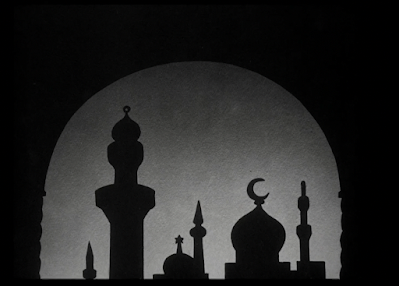





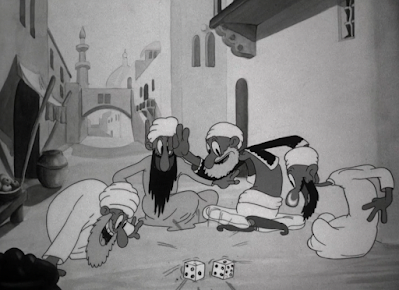





















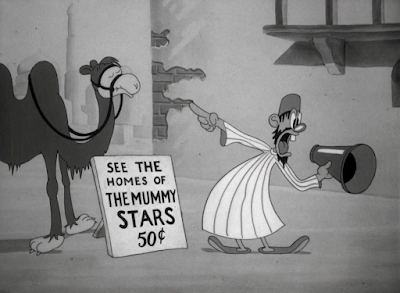







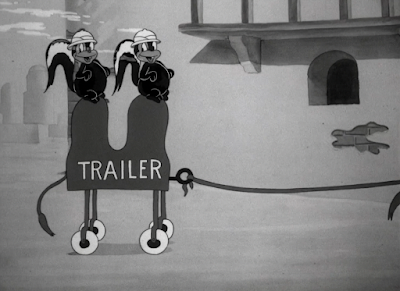











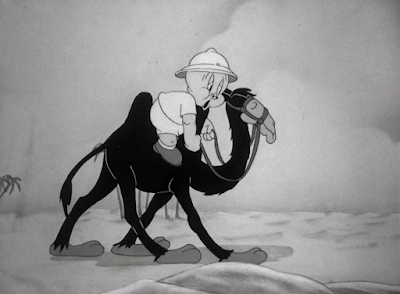






















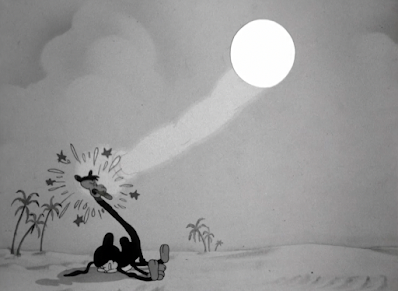











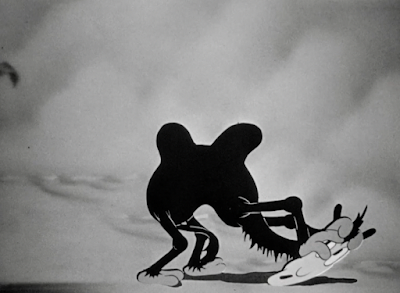
































































































No comments:
Post a Comment